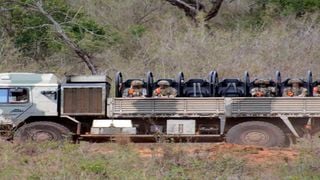
British Army soldiers at Lolldaiga training area in Laikipia County on November 14, 2022.
| File | Nation Media GroupNews
Premium
Own up, locals tell Batuk over Lolldaiga Hills fires
What you need to know:
- Reports confirm that between February and March 2021, at least six separate fires were reported.
- Scientists estimate it will take between 36 to 50 years of dedicated environmental efforts to restore vulnerable eco-systems to their original state following the fires.
By the time Lolldaiga Hills fully recovers from the destruction of the 2021 fire that was started by British soldiers, most middle-aged residents of the area and locals who were directly affected would probably be long dead.
Already, more than 50 locals have died from the effects of the fire, and an environmental assessment shows that Lolldaiga Hills will require the planting of more than 300,000 trees over 50 years to fully recover.
“Considering the life expectancy in Kenya averages 60 to 75 years, middle-aged residents are unlikely to enjoy a clean and healthy environment in their remaining productive life,” the legal representative of the Lolldaiga community, Mr Tom Macharia, says.
Even with the destruction of more than 12,000 acres in Laikipia County, British authorities have attempted to downplay the magnitude of the fire, extent of the damage and overall ecological effects while actively covering up incriminating details of the cause of the inferno.
The fire, according to official reports, started on March 24, 2021 during a training exercise by British Army Training Unit in Kenya (Batuk) soldiers and continued burning for more than five days.
The dates have however been disputed by locals, who maintain the fire started more than a week earlier.
Initially, news of the fire was made public by a British soldier on social media. He claimed the soldiers started a big fire that resulted in the death of up to six elephants.
The soldier would later be reprimanded for his “inappropriate” actions as British authorities went on to say the message was not entirely accurate.
By the time local and international media outlets started reporting on the blaze, it had been raging for more than three days as British soldiers and locals battled it.
Following extensive investigations, the Saturdan Nation can reveal previously hidden details into one of the worst environmental crimes and ecological destruction committed by English soldiers.
All these lay bare blatant desecration of one of Laikipia’s and the country’s most vulnerable ecosystems.
So bad is the destruction of this fragile ecosystem, which is home to endangered wildlife, that residents are beginning to leave as their lands have been rendered useless.
“Lolldaiga Hills is a catchment zone and a lifeline for thousands of families who depend on agriculture for their livelihood. The actions of the British Army have destroyed the environment and poisoned these lands,” lamented Africa Centre for Corrective and Preventive Action (ACCPA) director James Mwangi.
“Rather than wait to starve, the locals are selling their lands at throwaway prices and moving. The extent of the damage cannot be overlooked,”
ACCPA, a non-governmental environmental organisation, has been entangled in a civil claims suit against the British Army over the fire, accusing Batuk of environmental crimes.
“The fire had been burning on and off from as early as mid-March. The media learnt of it when it got out of hand,” a local who was working at Lolldaiga Conservancy at the time told the Saturday Nation.
Even then, the actual cause of the inferno remained hidden from the public, with the British Army strongly denying that explosives were responsible.
To date, British authorities insist the fire was not started by explosive. At some point, they claimed that British soldiers do not use live artillery rounds in training.
This claim by the United Kingdom Department of Defence was contradicted by Batuk Commander Duncan Mann, who told the Saturday Nation on record that the soldiers indeed use live explosives during training.
The Saturday Nation is also aware that at the time of the fire, the British Army was engaged in an intense battle simulation code name ‘Exercise Askari Storm’, which entailed the use of live bullets and artillery rounds.
Video footage by British Media outlets, which were given exclusive access during the exercise, also shows Batuk soldiers repeatedly setting off explosives in the conservancy.
But in a report submitted to the UK House of Commons, Armed Forces Minister James Heappey claimed that internal investigations by the British Department of Defence (DoD) showed that the cause of fire was a paraffin stove belonging to a soldier.
He added that the soldier accidentally knocked over the stove onto dry vegetation while he was heating his lunch.
Though Mr Heappey admitted the fire was started by British soldiers, he denied claims that firearms, explosives and drugs were involved.
“The British Army began an investigation into the cause of the fire whilst it was taking place and an Initial Learning Account was circulated internally on April 2, 2021,” he said in the letter dated December 19, 2022.
“This found that the likely cause of the fire was a paraffin ‘Dragon Fuel’ stove, of a type issued to soldiers to heat their rations in the field, being knocked over in an area that had not been adequately cleared of flammable material. There is no evidence that firearms, explosives or drug abuse were factors in the start of the fire or its subsequent spread.”
While this is plausible, the narrative is questionable. It is hardly believable that the British Army was able to control explosions from grenades, rockets and mortar rounds but not a “small fire” from a kerosene stove.
Similarly, the minister downplayed the extent of the damage, claiming “only” 7,000 acres were affected.
On March 28, 2022, the Kenya Wildlife Service (KWS) reported that 12,000 acres of Lolldaiga Hills were damaged by the fire.
The British minister downplayed the magnitude of the inferno, even blaming the media for exaggerating its seriousness.
Also Read: Intrigues behind Kenya-UK military deal
“The media impact of the fire was greatly amplified by the discovery that a soldier had posted an inappropriate message on social media, although this was actually posted four days before the fire broke out and referred to an earlier and much less serious incident,” Mr Heappey said.
The Saturday Nation has also gathered information showing the British Army covered up more fires in the past.
Multiple reports confirm that at least six fires had been reported in areas British troops had been training between February 24, 2021 and March 23, 2021.
The blazes, according to the British DOD records, were in Archer’s Post, Ole Maisor, Mpala and Ol’ Doinyo Lemboro in Laikipia and Samburu Counties.
It is, however, the Lolldaiga fire that resulted in the worst ecological damage.
An environmental assessment commissioned by an Inter-governmental liaison committee that was set up to hear the civil claims suit details the extent of the destruction, including the decimation of some endangered indigenous tree species.
The assessment was conducted by consultancy firm Howard Humphreys, which was previously based in the UK.
While the report does not clearly indicate the exact cause of the fire or the acreage of the burnt area, it estimates that more than 81 per cent of the above ground biomass was destroyed.
“The pre-fire forest stocking was 143.51 tonnes of above ground biomass per hectare. The fire destroyed an estimated 117.18 tonnes of above ground biomass per hectare. This translates to an emission of 201.95 tonnes of CO2 per hectare,” the report reads.
It adds that the fire was so big that emissions and particulates were dispersed as far as Lake Victoria and Kenya’s border with Tanzania.
The total amount of greenhouse gas emissions from the fire is estimated to have been 178,179.56 tonnes.
This can be equated to about seven per cent of the British military’s total greenhouse gas emissions between 2020 and 2021 which stood at about 2,527,000 tonnes.
The fire, according to the report, wiped out the Juniperus Procera (red cedar) tree species which are endangered and protected under a presidential ban against its exploitation.
To restore the damaged areas and reduce greenhouse emissions, the report recommends planting of more than 300,000 tree seedlings over a period of up to 50 years.
“We propose planting a half of these 800 seedlings per hectare (equal to 400 seedlings per hectare) to allow a complement between natural and artificial regeneration. In total, 316,154 seedlings will be required for this restoration,” it says.






